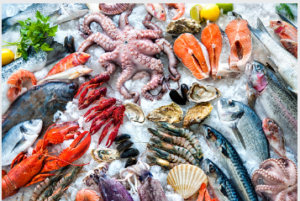Frozen seafood is an economical and nutritious way to stock your freezer. Not only is it more affordable and nutritious than fresh, but it has a longer shelf life and is better for the environment.
 Selecting quality frozen seafood and cooking it immediately, thawing as needed in cool water is essential. Doing this helps avoid freezer burn, dehydration, and oxidation.
Selecting quality frozen seafood and cooking it immediately, thawing as needed in cool water is essential. Doing this helps avoid freezer burn, dehydration, and oxidation.
It’s Fresher
Markwell Foods frozen seafood is an ideal way to have a nutritious meal on hand without having to make a memorable trip for shopping and cooking right away.
Environmentally speaking, frozen seafood is much friendlier to the environment as it doesn’t need to be transported around the globe, thus cutting back on greenhouse gas emissions and improving air quality in the process. It is especially true if you purchase sustainably caught frozen seafood from small-scale independent fishing families in the Caribbean or Alaska.
Calculating the optimal combination of freezing, thawing and cooking times to get maximum flavour and tenderness from your meal is vital. To do this, place the frozen item on a plate, then put it into the fridge for at least 8 hours. It is best to avoid trying to thaw seafood in the microwave as this often leads to poor results.
It’s More Affordable
One of the primary advantages of purchasing Markwell Foods frozen seafood is that it’s typically more affordable than fresh fish. It is due to its more reliable supply, which helps protect consumers from unexpected spikes in seafood prices.
According to a study from the Johns Hopkins Center for a Livable Future, 16% of edible seafood is lost annually due to spoilage or inefficient storage. This figure is exceptionally high regarding imported seafood which may not always be fresh in the U.S.
Frozen seafood can still be more economical than fresh since it requires less transport and storage costs. Furthermore, with its extended shelf life, frozen seafood is less likely to spoil before you use it.
Flash-frozen fish is not only more cost-effective, but it’s also better for your health and the environment. Shipping by boat instead of air reduces its carbon footprint, as does shipping across oceans or other countries.
Frozen fish is more nutrient-dense than fresh, as it has been rapidly and deeply frozen to preserve its essential elements. It helps maintain its natural structure longer while protecting proteins and fats that give it a distinct flavour.
It’s More Nutritious
Seafood is an excellent source of protein, essential omega-3 fatty acids, and vitamins B12, D, and E. Studies have found that seafood reduces the risks of heart attacks and strokes, boosts brain health, and protects against chronic illnesses like cancer or diabetes. Furthermore, it provides a great source of vitamin D which is crucial for bone and immune health.
Frozen seafood is more nutritional than fresh fish since it retains essential vitamins and minerals. Furthermore, frozen seafood has less of a chance of getting contaminated by bacterial growth while frozen.
Look for whole fish with no surface ice crystals, discolouration, or fillets that appear solidly frozen without ice particles inside the package. Bruising and freezer burn are indications of dehydration or oxidation, which may cause yellow-brownish-purple flesh.
Frozen seafood is not only more nutritious, but it’s also better for the environment in several ways. First and foremost, it reduces Earth’s carbon footprint. As National Geographic points out, shipping fresh fish by air is a highly polluting process; on the other hand, purchasing frozen seafood uses less fuel during transportation – something essential to save the planet and our health since flying contributes significantly to global warming.
It’s Better for the Environment
Many people assume fresh seafood is always the best option for a meal, but frozen seafood can be just as delicious and often healthier for the environment than its fresh counterpart.
Frozen seafood is generally more sustainable than fresh, as it can be transported via boat, truck or rail – cutting down on carbon emissions compared to air freight. Furthermore, frozen seafood reduces food waste – another win for the planet!
Flash freezing of seafood helps maintain its cell structure, minimising nutrient loss and keeping fish healthier. Furthermore, rapid freezing prevents bacteria growth that could lead to food spoilage or illness.
Flash freezing can help preserve the vibrant colours and flavours of seafood and make preparation easier by maintaining ingredients in their original states without extra salt or vinegar.
Consumers find frozen seafood more convenient, as it can be stored in the freezer for up to six months without defrosting. It gives them access to fresher seafood on days they most need it.
Food products generally have a carbon footprint, but measuring the environmental impact is challenging. That is why it is essential to consider the climate in which they were produced and how they were transported to their final destination. Furthermore, electricity used for fridge and freezer operations can significantly alter a product’s carbon footprint.
